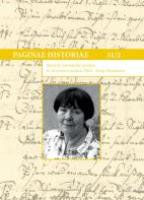Nevšední a zvláštní erbovní znamení v nobilitačních spisech České dvorské kanceláře
Unusual and Special Armorial Bearings in the Nobilitation Files of the Bohemian Court Chancellery
Author(s): Markéta HrdličkováSubject(s): History, Archiving, 17th Century, 18th Century
Published by: Národní archiv
Keywords: court office; nobilitation files; nobilitation; archival sources; coats of arms
Summary/Abstract: The process of ennoblement started by filing a supplica addressed to the emperor and processed by Bohemian Court Chancellery. The proceedings included a censorship of coats of arms-to-be. This was originally the duty of one of the officers of the Chancellery, but since the beginning of the 18th century, there was an especially appointed „Inspector of the arms“. The inspector made sure that the armorial achievements were according to the rules of heraldry. If there was a problem with the suggested achievement, the amendments could have been made by either changing the tinctures, correcting the charges or changing them. The colored pictures of armorial achievements are nowadays part of almost half of the cases of the Bohemian Court Chancellery. They are painted on smaller papers attached by small dots of red wax on the fourth or fifth page of the case, near the blason. In some cases, where these colored pictures were already missing when the cases were still part of the Chancellery archives, they are replaced by an ink-only drawing with just the letters replacing the colors.The most common variant is a quartered field, party per cross (or even with inescutcheon), the most popular charges are lions, eagles and griffins, ordinaries on the other hand are quite rare. The helms are almost always barred helms, no matter the exact rank of the supplicant. Torses are very rare, usually replaced by crest-coronets and in one case by a turban. The mantling is usually per pale both on the inside and outside, mostly red-gold and blue-silver, disregarding the colors of the shield.The crests usually repeat the charges of the escutcheon, but the most traditional ones like wings, horns and panaches of feathers were used as well.Unfortunately, cases where the documents mention anything about the reasons the armiger had for choosing the charges, are extremely rare and the only cases where we can be sure, are the canting arms.
Journal: Paginae Historiae
- Issue Year: 31/2023
- Issue No: 2
- Page Range: 118-135
- Page Count: 18
- Language: Czech

